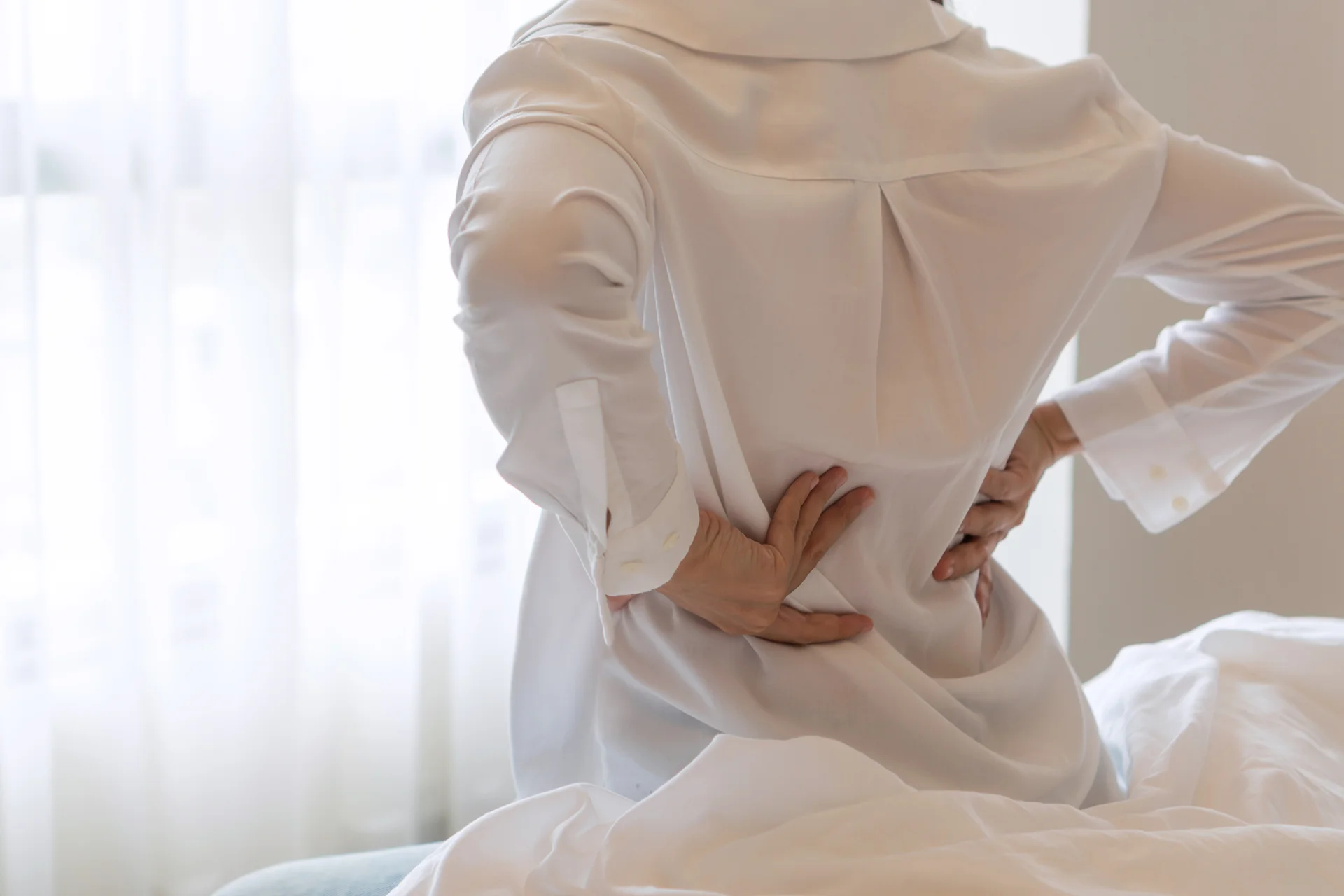It may seem like an overstatement to say that your middle back pain feels like someone is constantly stabbing you in the back. However, the way it lingers and the seesawing intensity make it seem that way.
The thought of living with it day in and day out – that’s a real downer. There’s always hope, though. With the right approach, you can put an end to this persistent torment.
Keep reading to finally identify why your mid back is acting up, learn how specialists tactically diagnose these types of issues, and discover proactive, proven methods to tame or banish this frustration for good.
What Characterizes Middle Back Pain?
First, let’s define what we mean by “middle back pain.” This type of back pain occurs specifically in the thoracic region of the spine, which spans from the base of the neck down to around the bottom of the rib cage.
Sometimes called the upper back, this section contains 12 vertebrae labeled T1 through T12. Middle back pain can occur anywhere throughout the thoracic spine.
Common symptoms include:
- Localized pain, tightness, or muscle spasms in the mid-back area
- Sharp pain in the middle back that may radiate around the trunk
- Dull, aching throb concentrated in the thoracic region
- Discomfort and stiffness when bending, twisting, reaching, or lying down
- Reduced mobility and flexibility in the mid-back
- Difficulty fully expanding the chest when breathing deeply
For many, middle back pain occurs on just one side, while for others, it spreads more generally across the thoracic spine area. The pain may be mild and occasional or severe and chronic.
Let’s look closer at the various causes and risk factors next.
What Causes This Back Pain?

There are many potential culprits behind pain in the mid back:
Muscular Strain
Like lower back pain, strained muscles are a leading cause of middle back discomfort. Overuse, improper lifting, poor posture, sports injuries, and simple chronic tension can overwork the muscles supporting the mid back, triggering painful spasms and tightness. Weak core muscles can also contribute to back strain.
Structural Spinal Issues
Problems with the spinal cord, discs, nerves, and other anatomical structures in the thoracic spine frequently cause pain.
For example, conditions like herniated discs, degenerative disc disease, spinal stenosis, and bone spurs put pressure on nerves, narrow the spinal canal, or restrict range of motion, leading to back pain of this kind.
Osteoporosis
Loss of bone density from osteoporosis can lead to painful compression fractures in the thoracic vertebrae. This causes the vertebrae to collapse and wedge together abnormally, compressing nerves.
Bad Posture
Slouching, hunching over, or sitting with rounded shoulders for extended periods compresses the mid-back area, tensing muscles and stressing the spine. Curvatures like scoliosis or kyphosis also alter thoracic spine positioning, putting uneven pressure across discs and joints and even leading to neck pain.
Certain Injuries
Any direct trauma to the mid back from a fall, car accident, or sports impact can damage muscles, joints, vertebrae, and discs, resulting in acute and chronic middle back pain. Whiplash injuries in particular commonly cause pain.
Heart Attack Symptom
Women may experience upper back pain as a primary symptom during a heart attack, rather than the expected chest pain The middle back discomfort could occur along with mild chest tightness or shortness of breath.
Referred Pain
Additionally, pain that originates from inflammation in nearby organs like the pancreas, kidneys, or aorta can refer to or radiate to the middle back area. This type of secondary back pain may accompany abdominal discomfort or chest pain, providing clues to the root cause.
Uncommon Causes
While less common, pain in the middle back can also stem from spinal abnormalities like tumors or infections, as well as inflammatory conditions like ankylosing spondylitis.
As you can see, this back pain has numerous and diverse possible causes. That’s why getting an accurate diagnosis from a doctor is imperative.
Various Ways of Diagnosing Middle Back Pain
Diagnosing the underlying reason for this back pain takes a multi-step approach:
Medical History
The doctor will ask detailed questions about your pain symptoms, location, severity, duration, and any triggering activities. Be prepared to describe any recent injuries. You’ll also discuss your medical history and any pre-existing conditions.
Physical Exam
A hands-on physical exam assesses posture alignment, range of motion, areas of tenderness, muscle tightness or spasms, strength, reflexes, balance, walking, and more. This can help pinpoint sources of thoracic pain.
Imaging Tests
If a serious spinal condition is suspected, the doctor may order imaging tests like X-rays, CT scans, or MRIs to visualize the thoracic vertebrae, discs, nerves (especially the intercostal nerves, thoracic spinal nerves, etc.), and soft tissues to check for damage, wear and tear, bone spurs, tumors, fractures, and alignment issues.
Specialized Tests
Additional diagnostic testing like nerve conduction studies, electromyography (EMG), and bone scans might be used to evaluate nerve damage or bone density issues. Blood tests can also check for signs of infection or inflammatory conditions.
Putting together findings from your history, physical examination, imaging, and other test results allows doctors to make an accurate diagnosis.
Common causes like muscle strain are fairly simple to identify, while more complex spinal problems may require collaboration between primary care doctors, orthopedists, neurologists, or rheumatologists. Don’t hesitate to ask for referrals to back pain specialists if needed.
How Is It Treated?
The right treatment depends on the underlying cause. Mild to moderate thoracic pain typically responds well to conservative at-home care, while severe or progressive cases may need specialist intervention or surgery. Common treatment options include:
| Treatment | Specific Advantage |
| Rest and Ice/Heat | Taking a break from strenuous activity allows mid-back tissues to heal. Apply ice packs to relieve pain and inflammation for the first 72 hours, then switch to moist heat. Avoid physical activities that aggravate your pain. |
| OTC Medication | Anti-inflammatories like ibuprofen or naproxen can ease swelling and discomfort. Acetaminophen and topical creams provide additional pain relief. |
| Physiotherapy | Physical therapists develop exercise programs to gently stretch and strengthen the thoracic back muscles. They also utilize massage, ultrasound, traction, joint mobilization, and other hands-on techniques to improve mobility and reduce pain. |
| Spinal Manipulation | Chiropractors or other specialists use techniques like spinal alignment or trigger point therapy to improve joint mobility and decompress the vertebrae. |
| Bracing/Taping | Stabilizing damaged thoracic vertebrae with a back brace limits movement and eases pain. Kinesiology taping also supports the mid-back muscles. |
| Injections | Steroid injections delivered into specific, painful inflamed areas of the thoracic spine can reduce local swelling and irritation of nerves or joints. |
| Surgery | If conservative treatment fails to adequately relieve pain and dysfunction, surgery like spinal fusion, discectomy, or laminectomy may be warranted in serious cases. This permanently stabilizes and decompresses the thoracic spine. |
Your doctor will determine the right course of treatment based on the cause and severity of your pain. Mild cases can often be managed at home, while moderate to severe pain may require specialist care like injections, advanced physiotherapy, or surgery.
The good news is, most patients see significant improvement using a combination of these options.
How Can I Manage and Prevent Back Pain of This Kind?
Alongside professional back pain treatment, you can take matters into your own hands with a few key prevention strategies:
- Maintain good posture – don’t slouch or hunch over when sitting or standing.
- Be diligent about core strengthening and flexibility exercises. Yoga, Pilates, and targeted back exercises improve muscle support.
- Lift heavy objects using proper mechanics – bend at the knees, keep the load close to your body, and avoid twisting.
- Stretch your mid-back muscles regularly before and after an activity.
- Use ergonomic furniture and equipment to prevent poor posture during work. Take frequent breaks.
- Sleep on a medium-firm mattress that supports the natural curves of your spine.
- Manage your weight to avoid excessive loading on the thoracic spine.
- Quit smoking – nicotine inhibits nutrient and oxygen delivery to spinal discs.
- Use caution and proper form with high-impact activities and contact sports that can injure the back.
Catching and addressing middle back pain early is key before it becomes a chronic issue. See your doctor at the first sign of throbbing, aching, or stabbing pain. With the right combination of conservative care, specialist treatment, spinal conditioning, and preventative lifestyle measures, the outlook for finding relief is excellent.
Quiet Your Middle Back Pain Now – Connect with a Specialist Through Kaly

Your journey in getting rid of this pain may be a winding one because there’s no one-size-fits-all solution. But with the right diagnosis, the correct treatments can effectively relieve discomfort.
By building core muscle strength, maintaining proper posture, using ergonomic equipment, and practicing safe lifting techniques, you can keep your mid back healthy.
If you’re struggling with stiff, aching mid-back pain that has not improved, we’re always here to help. We connect patients to top-rated doctors and chiropractors who specialize in treating middle back conditions.
You can schedule an online appointment with a back pain specialist who will evaluate your symptoms, diagnose the root cause, and create a customized treatment plan to get you out of pain and back to living the life you deserve.
Start your search now!
